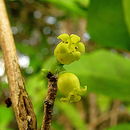en
names in breadcrumbs


Schoepfia is a genus of small hemiparasitic trees, flowering plants belonging to the family Schoepfiaceae. The genus has long been placed in the Olacaceae family.
Plants in this genus are small trees or shrubs which exhibit heterostyly - individuals can have both often cylindrical brachystylous (short styled) flowers and somewhat bell-shaped dolichostylous (longer styled) flowers. In most plants where heterostyly occurs, there is a sexual differentiation between flower types, the brachystylous flowers being functionally male, or one type of flower is cleistogamous or self-fertile. In Schoepfia species both flowers are bisexual and can form fruit, the reason for two flower forms is mysterious.[2]
The flowers are fragrant and small. They arise from a short peduncle which grows from the leaf axils of a stem. The peduncle is subtended by persistent, imbricate perular bracts. The flower is subtended by a three-lobed epicalyx, it is composed of a bract and two bracteoles, which are all united into a single structure. The actual calyx is inconspicuous, it is completely fused to the truncated, cup-shaped base of the flower. From the edges of this base, generally four or five petals arise, rarely three or six. The lower part of these petals are fused to each other to form a tube of sorts.[2]
The leaves of all species are simple, entire, alternate, penninerved and have petioles. The fruits are single-seeded drupes. The epicarp is derived from the swollen base of the flower.[2]

It is now placed in the Schoepfiaceae family.[1] The genus has long been placed in the Olacaceae family, although many researchers noted the differences between it and the rest of the family. Recent molecular studies have shown Schoepfia to be more closely related to the families Misodendraceae and Loranthaceae, and to uphold the criteria of monophyly it must be excluded from Olacaceae.[3][4]
The genus is split into three sections: two occur exclusively in Asia, with four species altogether, the third section, which includes the type species, only occurs in the Americas and contains all the other species.[2] The type species is Schoepfia schreberi.[5] One possible fossil species, †S. republicensis, has been described from Ypresian leaves found in the Klondike Mountain Formation of Washington state.[6]
As of April 2021, Plants of the World Online accepted the following species:[1]
The genus has a discontinuous distribution, being native to the Himalayas through China, Japan and Taiwan to Sumatra, and to tropical and subtropical America.[1] The genus is most diverse in tropical America.[2] Three species occur in territories belonging to the United States: Schoepfia arenaria, S. obovata and S. schreberi; S. schreberi occurs in Florida and the Caribbean, the other two are only found in the US Caribbean possessions.[8]
Species in this genus are root hemiparasites, deriving a portion of their nutrition by invading the roots and stealing the nutrients of neighbouring plants.[9] They do not appear to be very particular in choice of host plants. A 1979 study of Schoepfia schreberi in Florida and the Bahamas found haustoria (specialised organs on the roots used for parasitism) connected to ten different species, belonging to eight different botanical families. Haustoria were also firmly welded to the wrong things: rocks, buried pipes, concrete building foundations, etc.[2]
The young leaves of the S. schreberi are fed upon by the balloon-collared caterpillars of the metalmark butterfly Calydna sturnula, which are only known to feed upon this species.[10]
Schoepfia is a genus of small hemiparasitic trees, flowering plants belonging to the family Schoepfiaceae. The genus has long been placed in the Olacaceae family.
Schoepfia es un género de dicotiledóneas herbáceas y parásitas perteneciente a la familia Schoepfiaceae.[3] Abarca unas 30 especies nativas de América y Asia tropical. El género estuvo incluido durante muchos años dentro de las olacáceas pero los estudios filogenéticos recientes, basados en datos moleculares, indican que está muy poco relacionado con los restantes miembros de esa familia.[4]
Árboles o arbustos inermes, parásitos de raíces de otras plantas. Presentan hojas simples, alternas. Las inflorescencias son paucifloras, racimos generalmente fasciculados en las axilas de las hojas, bracteadas o no. Las flores son hermafroditas; con el cáliz extremadamente pequeño, ciatiforme o crateriforme, con el margen subentero; presentan de 3 a 6 pétalos, unidos entre sí formando un tubo campanulado, a veces pubescentes internamente, los lóbulos valvados, reflexos, blancos, amarillos o rojos. El androceo es isómero respecto al perianto, los estambres antipétalos y unidos al tubo que forma la corola, sésiles o subsésiles, las anteras dehiscentes por hendiduras longitudinales. El ovario con los óvulos péndulos, sin tegumentos, el estilo es delgado y el estigma posee dos o tres lóbulos. El fruto es una drupa, unida y encerradas por el cáliz acrescente, de color verde a rojo.[5][6]
Schoepfia es un género de dicotiledóneas herbáceas y parásitas perteneciente a la familia Schoepfiaceae. Abarca unas 30 especies nativas de América y Asia tropical. El género estuvo incluido durante muchos años dentro de las olacáceas pero los estudios filogenéticos recientes, basados en datos moleculares, indican que está muy poco relacionado con los restantes miembros de esa familia.
Schoepfia é um género botânico pertencente à família Olacaceae o Schoepfiaceae.[1][2]
Schoepfia é um género botânico pertencente à família Olacaceae o Schoepfiaceae.
Schoepfia Schreb., 1789
Schoepfia (лат.) — род двудольных растений семейства Шёпфиевые (Schoepfiaceae). Выделен немецким натуралистом Иоганном Христианом Шребером в 1789 году[2].
Типовой род семейства шёпфиевых[3].
В состав рода входят 25 принятых видов[4]:
Представители рода встречаются в тропических и субтропических районах Азии и обеих Америк[5].
Деревья либо кустарники. Цветущие и плодоносящие ветви истончаются и часто опадают[уточнить][5].
Листья с перистыми прожилками, размещены очерёдно[5].
Цветки с трубчатым, колокольчатым или кувшинчатым венчиком, ароматные, собраны в кистевидное либо колосовидное соцветие[5].
Плод — костянка с одним семенем[5].
Schoepfia (лат.) — род двудольных растений семейства Шёпфиевые (Schoepfiaceae). Выделен немецким натуралистом Иоганном Христианом Шребером в 1789 году.
Типовой род семейства шёпфиевых.
香芙木属(学名:Schoepfia)是铁青树科下的一个属,为灌木或乔木植物。该属共有15种,分布于热带地区。[1]